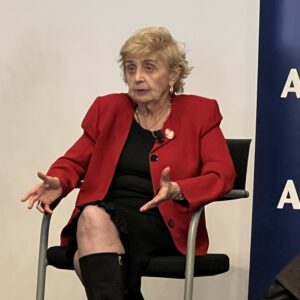Tova Friedman was 6 years old when the Russians liberated Auschwitz.
Friedman and her mother had hidden beside corpses under blankets in an infirmary, rather than following orders to go on what was later known to be a death march with fleeing German SS soldiers. Friedman, 86, spoke Sunday at the Weitzman National Museum of American Jewish History, telling a rapt audience how she survived the Holocaust as a young child.
Friedman is also known as “TikTok Tova,” after her grandson, Aaron, encouraged her to use TikTok to record short videos about her experiences during the Holocaust.
“What’s scary is many young people will not meet a survivor,” said Friedman. “And they will be told in colleges and high schools: ‘It probably never happened. It’s an exaggeration. You know the Jews. They want everybody to be sorry for them.’”
“That’s been happening to my grandchildren,” she said. One grandson is at Cornell, and he called her to ask whether he should wear his Star of David necklace in public or hide it under his shirt. She told him, ‘Do you want to be a visible Jew or a hidden Jew? I know that life has changed. America is different.’ A granddaughter at McGill University in Montreal had to leave her dormitory and live in an apartment because of antisemitism.
“I talk for the people who were murdered, 1.5 million children and 6 million Jews,” said Friedman. “They cannot be forgotten.”
“The other reason I speak is a warning,” she said. “I feel this world is turning against us. We have been scapegoats all through history.”
Her mother died young, at 45. “She couldn’t get over it,” she said. Her father handled life after the Holocaust a little bit better.”
“In my (Polish) town, there were hundreds of Jewish children,” said Friedman. “At the end of the war, there were five left. Five. I’m the youngest.” The Highland Park, N.J. resident went back to see it and “it’s like we (Jews) weren’t even there.”
“I remember the ghetto at the age of 4. There were lots of people in a tiny apartment, no running water, no food,” she said. She heard the adults talking. “Children know everything,” she said. “I knew they were killing children, and I have to be under the table. I knew that my grandparents are going to die soon…One day (Nazis) took my grandmother and they shot her, right outside the window.”
“Hitler was brilliant…Idiots could not have one what he did,” she said. The Nazis came to each village with a preplanned “template” to kill all the children and the older people, leaving the younger adults who could be used as slave labor, she said.
“Break up the family, and you will break up people,” she said. “Kill all the rabbis. Kill all the teachers. Kill the president of a shul (synagogue).”
“There was nothing left but scared people in the 20s and 30s,” she said. “The Germans used us to help them win the war…We, the Jews, dug graves for our children and our parents.”
“We were starving,” she said. A nutritionist, “a Ph.D. the best nutritionist in Germany, told Hitler how much to feed us, in order (for them to die).” Along with starvation, many people died of typhus, she said. And each ghetto had a designated concentration camp “where you would be killed en masse.”
Eventually, her parents were separated. “My father was crying.” Her father went to the Dachau concentration camp. Friedman and her mother were sent to Auschwitz. Her father said, “Be a good girl.” She described a nightmare trip crammed into a cattle car with other women for 36 hours with no food, drink, or toilets.
“That was a dividing line between being human and being inhuman,” she said. “When we walked out, we were all covered with feces.”
At Auschwitz, they removed their soiled clothing and were checked for health. “Don’t look at the eyes of the dogs…Never have eye contact (with anybody). Eye contact will make you recognized.” And to never run from the dogs. “She trained me how to be self-sufficient.”
While most children were immediately sent to the crematorium, she was not.
At one point, Friedman fell into a latrine and got sick. Although she recovered, the captors sent her to stay with other children, and a tattoo was inked on her arm. She also remembered waiting in line with children outside a gas chamber, only to be sent back to their barracks for an unknown reason.
Friedman recounts her entire story in her New York Times bestseller, “The Daughter of Auschwitz,” written with Malcolm Brabant, which is coming out in an edition for young people next week.
Pennsylvania does not require that students learn about the Holocaust. Rep. Kristin Marcell R-Richboro) and Rep. Joe Hogan (R-Penndel) sponsored a bill to require the Department of Education to write curriculum guidelines for schools offering Holocaust and genocide lessons and require transparency so parents would know what their children are learning and another to study and report on Holocaust curriculum. Marcell said the bills were sent to the Education Committee on March 3.
American Jewish Committee Regional Director Marcia Bronstein introduced Friedman and discussed a new survey that documents rising antisemitism in the U.S. The newly released 2024 poll includes 1,732 Jewish people and 2,056 other members of the public. It showed “77 percent of Jewish respondents feel less secure due to the Oct. 7 attack. One-third of American Jews have been targeted in person or online in the last 12 months. And nearly 6 in 10 Americans report changing their behavior in fear of antisemitism.”
During the event, AJC podcaster Manya Brashear Pashman, who moderates “People of the Pod,” recorded interviews with Friedman and Lise Marlowe, program director of the Holocaust Awareness Museum and Education Center (HAMEC) in Elkins Park.

